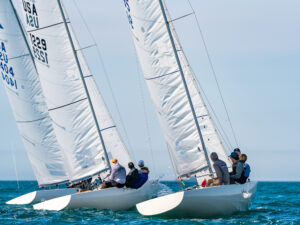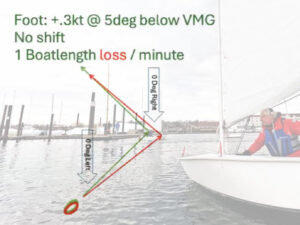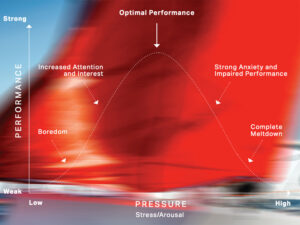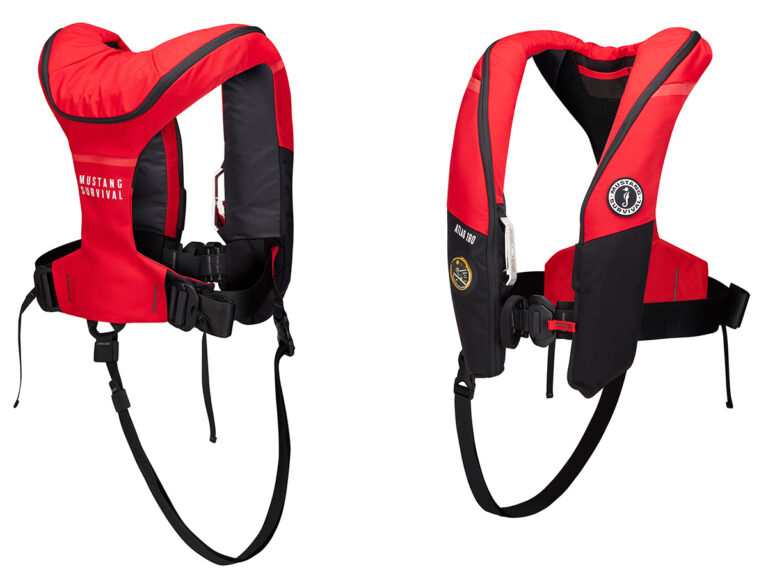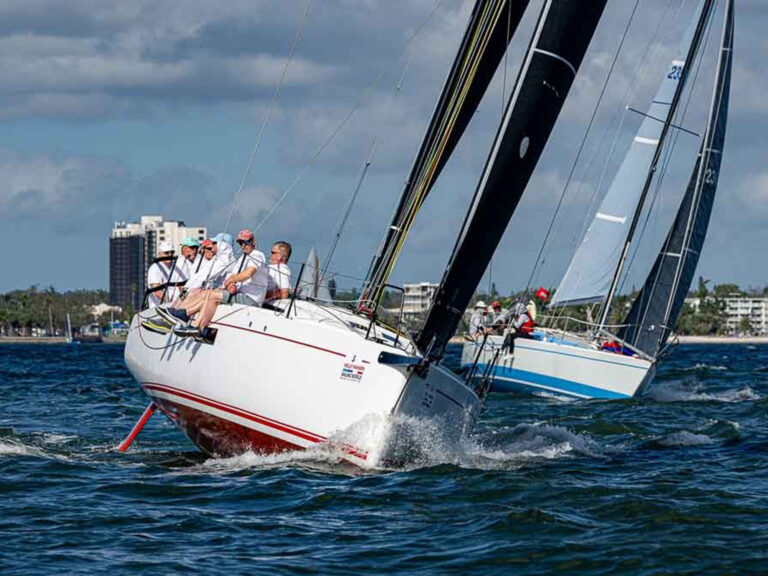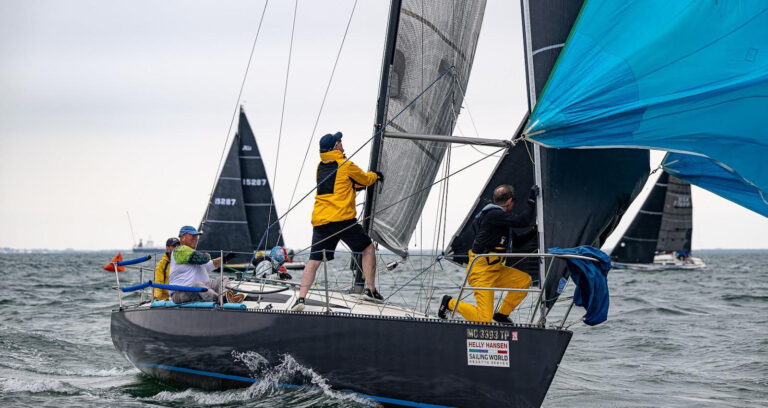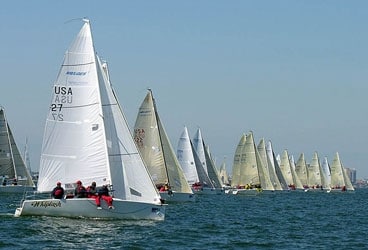
MarExpSt
One great aspect of our sport is that every sailor will occasionally win a race, or is at least capable of doing so. To put together a series of top finishes over the course of a day, or many days, however, takes experience and regatta management. From sailing hundreds of races a year, college sailors know a good regatta strategy produces the lowest average point total, which ultimately wins the regatta.There are many lessons to be learned from the collegiate racecourse, first and foremost among them is the importance of boatspeed. The adage that speed makes you look smart is very true. With good speed it’s easier to jump out at the start and stay near the front of the pack, and if you do fall back into the pack, speed makes it easier to pass boats. There are countless ways to improve your boatspeed, but a good place to start is getting a tuning guide from your sailmaker and setting aside practice time at the beginning of each sailing season to work with a tuning partner. The top sailors are fast in all conditions and avoid being optimized for only one type of condition, so improve upon the conditions in which you’re weakest. Then, at each regatta, work with your partner to dial in your speed before the start of each race. Don’t just sit there while the veterans take their speed runs. Perhaps you can even ask to join in with them. Your goal should be to start every race at or near top speed.If you have the speed you need, the major challenge while racing then becomes decision making. After sailing hundreds of races a year, the top college sailors learn to anticipate tactical boat-to-boat situations before they happen and avoid simply reacting to an approaching boat. In other words, they learn to think two or three moves ahead. Armed with a tactical vision of how a particular boat-to-boat encounter is going to play out, they can concentrate on executing their moves. Once a tactical decision is made, they sail it out, give it time, analyze whether or not the move worked, then make any necessary adjustment.Another important element of anticipation is to understand the strategic implications of the conditions before the race begins. Keep it simple by categorizing a race into one of three basic types-oscillating breeze, one-side favored, and unknown. In oscillating conditions you must first find the median wind direction. Don’t worry too much about timing the shifts; it’s more important to understand where the mean is in relation to both the high and low readings on both tacks.The goal of racing in an oscillating breeze is to make sure you tack on the lift before it returns to the mean. Stay in phase, sail fast on the lifts, and sail toward the new shift. When you can consolidate on boats, do so by leading nearby boats to the new shift before they consolidate on you when on the opposite tack. Try to stay in the middle of the course, avoid laylines, and treat the last shift into the mark as a persistent shift. Finally, remember to update your mean wind direction throughout the day. With an one-side-favored course, it’s important to understand why one side is favored. Determine whether it’s a geographic shift, a persistent shift, or a current advantage that makes a side favored. Then go early to that side, stay with the group headed that way, and use your leverage to gain on boats. Be careful to balance how far you sail into the favored side and remember to keep tabs on those around you-sail only as far into the side as you need to be ahead of them and avoid overstanding the weather mark.If you don’t know what conditions to expect on the upwind leg, consider sailing in the middle of the course. Try to keep your bow on the tack closest to the mark; this is the lifted tack. Regardless of the conditions, if you sail the lifts or long tack into the middle, you’ll keep your options open and be ready for anything as the race progresses. In order to make a sound tactical decision as the race progresses, you must understand how the following will affect your race: line management, risk versus leverage, and offense versus defense.Line managementCollegiate sailing is revered for the amount of actual starts a sailor experiences in a single season. From all of this experience, college sailors understand the two schools of thought when it comes to starting. The first is to start near the middle of the line when there’s no clear advantage. Use a mid-line start when the line is square, the courses are long, the breeze is up, or you know you have superior boatspeed. With a conservative approach you can also consider moving toward the favored third of the line, avoiding the risks of starting at the end in the mess of a pack, yet benefiting from any line bias or one-side advantage. In other words, the conservative mid-line start keeps you in the game. The second school of thought is to challenge for an end of the line and head immediately toward the advantaged side. Doing so is paramount only on a short course where there’s clearly a favored side, or the starting line so heavily favored that the boat that reaches the advantage first wins the race. This is where experience comes into play, and realizing that it’s only worth taking the risk to win the advantaged side when one end or side is heavily favored. Starting near the end of the line, and only getting a third place in the race may cost you points in the short run, but in the long run it’s a low score that could win you the regatta. With either approach, you need to be at full speed on the line at zero seconds, in all conditions.Risk and leverageLeverage is often referred to as the distance between boats, and how a windshift or wind speed variation affects those boats. Basically, if the wind shifts left with two boats sailing upwind, the left boat gains. If the wind shifts right, the right boat gains. The boat that sails in more wind usually goes faster. But leverage is more complicated than that, and the actual gains a boat makes in a windshift can be calculated if you know the distance between the boats, and the amount of degrees the wind shifted. College sailors sailing short courses don’t have time to make such calculations, but they do understand risk and leverage. The further apart the boats are, the more one gains when the wind shifts, thus the risk increases. But you don’t gain with leverage until you have consolidated with your opponents.How do collegiate sailors typically manage risk and leverage on the short course? The top sailors always lead boats into the new shift or more pressure, an immediate gain on the fleet. Second, they cross when they can, and don’t let a competitor cross. Third, they avoid the corners and laylines. Holding to the middle of the course allows you to minimize losses if you get to the wrong side, or didn’t go hard enough into a shift. Remember, we’re sailing for the best average score of all the races. You have the rest of the race to pass boats-the goal is to be in the top five at the weather mark.Offense versus defenseWhen you find yourself in the middle of the pack during a race, trying to pass boats, you’re sailing in an offensive mode. A good way to claw through the pack is to sail in a mode where your goal is to position yourself to pass boats. When trying to pass boats upwind from behind, you must first realize that there are no clean lanes in the pack, and other boats will try to keep you behind them. But you still need to find the best lane toward the next shift or the favored side of the course. Don’t waste time sailing the wrong tack for a long time looking for a clean lane. Settle on a lane that keeps you in the game. Then look to consolidate when you have made gains. Pass groups of boats early in the race and then pick off individual boats as you approach the finish, avoiding the one-on-one battles. When trying to pass boats, take only educated gambles. If you sail the shifts and lanes smarter than the other boats, you’ll pass them. When sailing in a defensive mode within a race, you’re sailing not to lose places. When at the front of the fleet during a race, or at any time in a series, you’re trying to maintain a point spread with an opponent by not adding additional points to your score. In college sailing there’s an expression, “Low average wins.” Your goal is to minimize your points in all the races sailed and keep your score lower than the entire fleet. That’s why it’s important to race against the fleet, while avoiding tight covers, tacking duals and one-on-one battles, which only drag you deeper into the fleet and worsen your average score. There’s another expression in college sailing, “Keep your third.” You need to understand that sometimes you go after boats, and other times you don’t. When in third, why would you risk taking a gamble to pass two boats if it possibly meant losing more than two points?Pick your battlesIn college sailing we always use the expression that it sometimes, “pays to lose a battle if you can win the war.” Simply stated, you have to understand how to race against an individual within the fleet, within a group against the fleet, and each race within a series. For example, what do you do when there’s a strong favorable current on one side of the course and a competitor breaks from the pack and sails into adverse current? Do you buck or race the trend? When the strategic factors are clear and the decisions are limited, race the trend and sail with the favorable current. Have confidence to win the race with superior boatspeed and handling within the pack.Racing against a group within a fleet is often a difficult concept to understand. There are a number of boats you’re not racing during a regatta. They are not your competition. Yes, you are trying to beat the entire fleet, but pinpoint the competitive boats; keep track of them because they’re your competition. Race against the boat who you know will be at the top of the leader board at the end of the regatta, and let the others go. You don’t need to cover all the competition-you just need to stay in touch.In order to win a regatta, you need to carefully pick your battles. You have to decide when and when not to split from your competition. You don’t get extra points for winning a race by taking more risk. You win races and regattas by managing your risk, picking your battles, and minimizing your points.Finally, avoid the big mistakes, which includes the first-race gamble-you can’t win a regatta in the first race, but you can lose it. Stay in the regatta by sailing the first race conservatively. Avoid putting letters on the scoreboard by checking over your boat to avoid a breakdown, having a sense of where the starting line is, and watching for individual recalls after every start. Avoid collisions, and if you do make contact and you’re in the wrong, take the penalty. Any places you lose by doing a penalty turn are better than a DSQ.Remember, to win a regatta you have to have confidence in your boathandling, boatspeed, and tactics. If you have that, you should then have the patience to sail your own race decisively. Confidence, patience, and decisiveness-they keep you in the hunt at all times.

